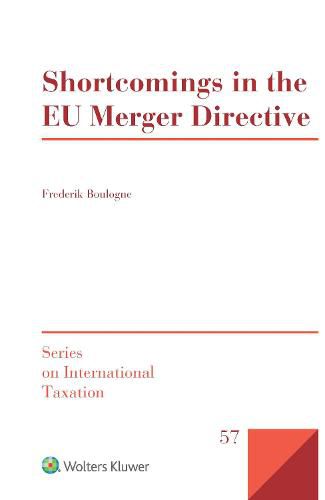Readings Newsletter
Become a Readings Member to make your shopping experience even easier.
Sign in or sign up for free!
You’re not far away from qualifying for FREE standard shipping within Australia
You’ve qualified for FREE standard shipping within Australia
The cart is loading…






The European Union (EU) Merger Directive removes certain tax disadvantages encountered by companies and their shareholders in the course of a restructuring operation. However, in spite of amendments and European Court of Justice’s (ECJ) interpretations of its provisions, various shortcomings remain. This thoroughgoing analysis, broader and deeper than any prior work on the subject, addresses all the Directive’s subtopics methodically, following the paragraphs of Articles 1-15 in their logical succession. The author analyses the points in which the Merger Directive falls short of attaining its stated objective, and he also examines how these shortcomings could be scaled. To do so, he tests the Merger Directive against its own objective, primary EU law (the fundamental freedoms and the unwritten general principles of EU law) and non-discrimination provisions in relevant treaties.
Each of the following questions is addressed and responded to in depth:
Which entities have access to the Merger Directive and which entities should have access to it?
Which operations are covered by the Merger Directive and which operations should be covered?
Which tax disadvantages to cross-border restructuring operations does the Merger Directive aim to remove, which tax disadvantages have been actually removed, which tax disadvantages remain, and how should the Merger Directive be amended to remove the remaining tax disadvantages?
How tax avoidance should be combated under Article 15(1)(a) of the Merger Directive, which possible types of tax avoidance can be identified, and how the Merger Directive should be amended?
Which cases of double taxation does a taxpayer engaging in cross-border restructuring operations potentially encounter, and how they can be taken away by the Merger Directive?
The key shortcomings that are identified are: the Merger Directive’s objective is not stated precisely; minimum harmonisation does not lead to a common tax system; exhaustive lists are used as legislative technique; the Merger Directive does not add much to the outcomes reached through negative harmonisation; and the definitions of qualifying operations are not fully aligned with corporate law. Chapter 6 contains a deeply informed and viable proposal for the amendment of the Merger Directive.
This is the first treatment not only to evaluate the Directive’s efficacy in detail but also to offer real solutions to its shortcomings. It will be welcomed by policymakers, judges, practitioners and academics, and the recommendations it contains are sure to affect ongoing amendments and jurisprudence on the Merger Directive.
$9.00 standard shipping within Australia
FREE standard shipping within Australia for orders over $100.00
Express & International shipping calculated at checkout
The European Union (EU) Merger Directive removes certain tax disadvantages encountered by companies and their shareholders in the course of a restructuring operation. However, in spite of amendments and European Court of Justice’s (ECJ) interpretations of its provisions, various shortcomings remain. This thoroughgoing analysis, broader and deeper than any prior work on the subject, addresses all the Directive’s subtopics methodically, following the paragraphs of Articles 1-15 in their logical succession. The author analyses the points in which the Merger Directive falls short of attaining its stated objective, and he also examines how these shortcomings could be scaled. To do so, he tests the Merger Directive against its own objective, primary EU law (the fundamental freedoms and the unwritten general principles of EU law) and non-discrimination provisions in relevant treaties.
Each of the following questions is addressed and responded to in depth:
Which entities have access to the Merger Directive and which entities should have access to it?
Which operations are covered by the Merger Directive and which operations should be covered?
Which tax disadvantages to cross-border restructuring operations does the Merger Directive aim to remove, which tax disadvantages have been actually removed, which tax disadvantages remain, and how should the Merger Directive be amended to remove the remaining tax disadvantages?
How tax avoidance should be combated under Article 15(1)(a) of the Merger Directive, which possible types of tax avoidance can be identified, and how the Merger Directive should be amended?
Which cases of double taxation does a taxpayer engaging in cross-border restructuring operations potentially encounter, and how they can be taken away by the Merger Directive?
The key shortcomings that are identified are: the Merger Directive’s objective is not stated precisely; minimum harmonisation does not lead to a common tax system; exhaustive lists are used as legislative technique; the Merger Directive does not add much to the outcomes reached through negative harmonisation; and the definitions of qualifying operations are not fully aligned with corporate law. Chapter 6 contains a deeply informed and viable proposal for the amendment of the Merger Directive.
This is the first treatment not only to evaluate the Directive’s efficacy in detail but also to offer real solutions to its shortcomings. It will be welcomed by policymakers, judges, practitioners and academics, and the recommendations it contains are sure to affect ongoing amendments and jurisprudence on the Merger Directive.